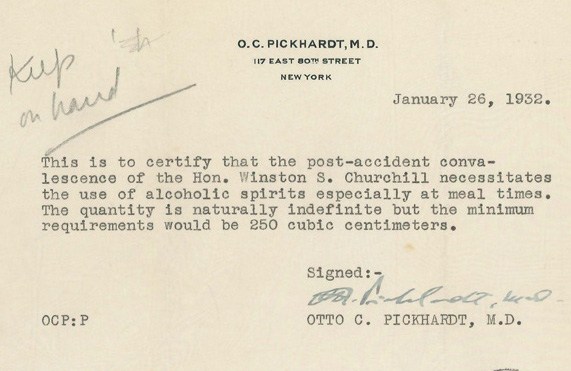
In December 1931, having just embarked on a 40-stop lecture tour of the United States, Winston Churchill was running late to dine with financier Bernard Baruch on New York City’s Upper East Side. He hadn’t bothered to bring Baruch’s address, operating under the incorrect assumption that his friend was so distinguished a personage, any random cab-driving commoner would automatically recognize his building.
Such were the days before cell phones and Google Maps.…
Eventually, Churchill bagged the cab, and shot out across 5th Avenue mid-block, thinking he would fare better on foot.
Instead, he was very nearly “squashed like a gooseberry” when he was struck by a car traveling about 35 miles an hour.
Churchill, who wasted no time peddling his memories of the accident and subsequent hospitalization to The Daily Mail, explained his miscalculation thusly:
In England we frequently cross roads along which fast traffic is moving in both directions. I did not think the task I set myself now either difficult or rash. But at this moment habit played me a deadly trick. I no sooner got out of the cab somewhere about the middle of the road and told the driver to wait than I instinctively turned my eyes to the left. About 200 yards away were the yellow headlights of an approaching car. I thought I had just time to cross the road before it arrived; and I started to do so in the prepossession—wholly unwarranted— that my only dangers were from the left.
Yeah, well, that’s why we paint the word “LOOK” in the crosswalk, pal, equipping the Os with left-leaning pupils for good measure.
Another cab ferried the wounded Churchill to Lenox Hill Hospital, where he identified himself as “Winston Churchill, a British Statesman” and was treated for a deep gash to the head, a fractured nose, fractured ribs, and severe shock.
“I do not wish to be hurt any more. Give me chloroform or something,” he directed, while waiting for the anesthetist.
After two weeks in the hospital, where he managed to develop pleurisy in addition to his injuries, Churchill and his family repaired to the Bahamas for some R&R.
It didn’t take long to feel the financial pinch of all those cancelled lecture dates, however. Six weeks after the accident, he resumed an abbreviated but still grueling 14-stop version of the tour, despite his fears that he would prove unfit.
Otto Pickhardt, Lenox Hill’s admitting physician came to the rescue by issuing Churchill the Get Out of Prohibition Free Pass, above. To wit:
…the post-accident convalescence of the Hon. Winston S. Churchill necessitates the use of alcoholic spirits especially at meal times. The quantity is naturally indefinite but the minimum requirements would be 250 cubic centimeters.
Perhaps this is what the eminent British Statesman meant by chloroform “or something”? No doubt he was relieved about those indefinite quantities. Cheers.
Read Churchill’s “My New York Misadventure” in its entirety here. You can also learn more by perusing this section of Martin Gilbert’s biography, Winston Churchill: The Wilderness Years.
Note: An earlier version of this post appeared on our site in 2016.
Related Content:
What Happens When Mortals Try to Drink Winston Churchill’s Daily Intake of Alcohol
Oh My God! Winston Churchill Received the First Ever Letter Containing “O.M.G.” (1917)
Winston Churchill Goes Backward Down a Water Slide & Loses His Trunks (1934)
Ayun Halliday is an author, illustrator, and Chief Primatologist of the East Village Inky zine. She lives in New York City, some 30 blocks to the north of the scene of Churchill’s accident. Follow her @AyunHalliday
A staple of Andean diets for thousands of years, quinoa (KEEN-wah) has been touted as a superfood recently for its high protein content and potential to solve hunger crises. It’s represented by the usual celebrities: Kate Moss, Gwyneth Paltrow, Jennifer Aniston … and David Lynch. Oh yes, have you not tried David Lynch’s quinoa recipe? Well, you must. If you’ve remained unswayed by the glitterati, perhaps this very Lynchian of pitches will turn you on to the grain. Watch the first part of Lynch’s video recipe above, part two below. It opens at peak Lynch: pulsing ominous music, garish lighting, and the obsessive kind of patience for the slow build that may be David Lynch’s alone.
By Part Two of Lynch’s video recipe, we are fully immersed in a place seemingly far away from quinoa, a place of the portentous topography of David Lynch’s inner life. Everyday objects take on a mysterious glowing resonance. Small ritualistic exchanges stand in for global shifts of consciousness.
So in a way, maybe we’re still close to the magic of quinoa. Lynch made the short video as an extra for the 2006 Inland Empire DVD. As Dangerous Minds points out, its current YouTube iteration “looks like crap” and “there’s at least a couple of minutes missing… it’s still worth a look.”
If you don’t have David Lynch’s patience but do have his taste for quinoa, read the full recipe below. It’s likewise full of delightful asides and digressions.
Yield: 1 bowl
Cooking Time: 17 minutes
Ingredients:
1/2 cup quinoa
1 1/2 cups organic broccoli (chilled, from bag)
1 cube vegetable bullion
Braggs Liquid Aminos
Extra virgin olive oil
Sea salt
Preparation:
* Fill medium saucepan with about an inch of fresh water.
* Set pan on stove, light a nice hot flame add several dashes of sea salt.
* Look at the quinoa. It’s like sand, this quinoa. It’s real real tight little grains, but it’s going to puff up.
* Unwrap bullion cube, bust it up with a small knife, and let it wait there. It’ll be happy waiting right there.
* When water comes to a boil, add quinoa and cover pan with lid. Reduce heat and simmer for 8 minutes.
* Meanwhile, retrieve broccoli from refrigerator and set aside, then fill a fine crystal wine glass—one given to you by Agnes and Maya from Lódz, Poland—with red wine, ‘cause this is what you do when you’re making quinoa. Go outside, sit, take a smoke and think about all the little quinoas bubbling away in the pan.
* Add broccoli, cover and let cook for an additional 7 minutes.
* Meanwhile, go back outside and tell the story about the train with the coal-burning engine that stopped in a barren, dust-filled landscape on a moonless Yugoslavian night in 1965. The story about the frog moths and the small copper coin that became one room-temperature bottle of violet sugar water, six ice-cold Coca-colas, and handfuls and handfuls of silver coins.
* Turn off heat, add bullion to quinoa and stir with the tip of the small knife you used to bust up the bullion.
* Scoop quinoa into bowl using a spoon. Drizzle with liquid amino acids and olive oil. Serve and enjoy.
If you would like to sign up for Open Culture’s free email newsletter, please find it here.
If you would like to support the mission of Open Culture, consider making a donation to our site. It’s hard to rely 100% on ads, and your contributions will help us continue providing the best free cultural and educational materials to learners everywhere. You can contribute through PayPal, Patreon, and Venmo (@openculture). Thanks!
Related Content:
Salvador Dalí’s 1973 Cookbook Gets Reissued: Surrealist Art Meets Haute Cuisine
Josh Jones is a writer and musician based in Durham, NC. Follow him at @jdmagness
?si=BKqiiloz1aFahBfk
How do you pour a beer? You think you know the answer. You’re pouring the beer into a tilted glass, and minimizing the foam. According to Max Bakker, a Master Cicerone (or sommelier for beer), you’re getting it wrong. Above, he demonstrates the proper technique. Watch and learn.
If you would like to sign up for Open Culture’s free email newsletter, please find it here.
If you would like to support the mission of Open Culture, consider making a donation to our site. It’s hard to rely 100% on ads, and your contributions will help us continue providing the best free cultural and educational materials to learners everywhere. You can contribute through PayPal, Patreon, and Venmo (@openculture). Thanks!
Related Content
Watch Beer Ferment in Time-Lapse Motion, and Then Learn How to Make Beer with an Animated Video
Discover the Oldest Beer Recipe in History From Ancient Sumeria, 1800 B.C.
How to Make Ancient Mesopotamian Beer: See the 4,000-Year-Old Brewing Method Put to the Test
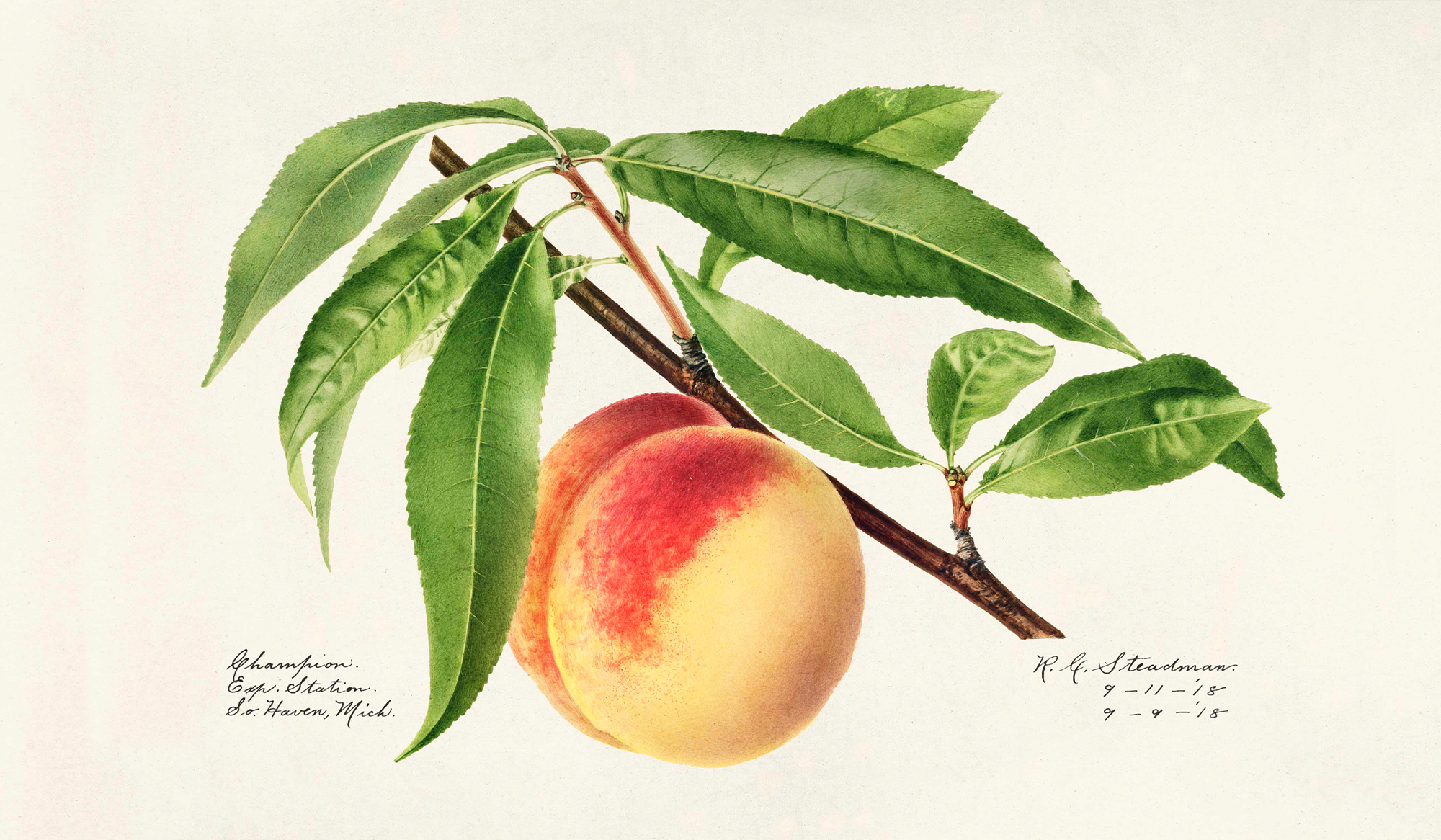
A picture is worth 1000 words, especially when you are a late-19th or early-20th century horticulturist eager to protect intellectual property rights to newly cultivated varieties of fruit.
Or an artistically gifted woman of the same era, looking for a steady, respectable source of income.
In 1886, long before color photography was a viable option, the US Department of Agriculture engaged approximately 21, mostly female illustrators to create realistic renderings of hundreds of fruit varieties for lithographic reproduction in USDA articles, reports, and bulletins.
According to the Division of Pomology’s first chief, Henry E. Van Deman, the artists’ mandate was to capture “the natural size, shape, and color of both the exterior and interior of the fruit, with the leaves and twigs characteristic of each.”
If a specimen was going bad, the artist was under strict orders to represent the damage faithfully – no prettying things up.
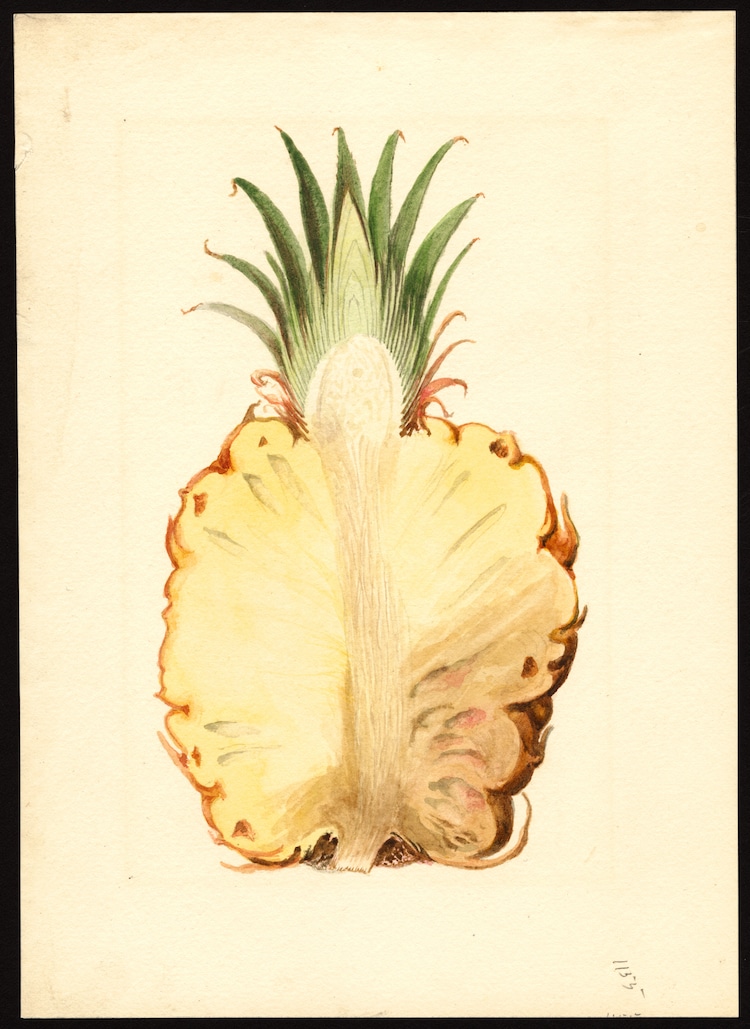
As Alice Tangerini, staff illustrator and curator for botanical art in the Smithsonian’s National Museum of Natural History writes, “botanical illustrators and their works serve the scientist, depict(ing) what a botanist describes, acting as the proofreader for the scientific description:”
Digital photography, although increasingly used, cannot make judgements about the intricacies of portraying the plant parts a scientist may wish to emphasize and a camera cannot reconstruct a lifelike botanical specimen from dried, pressed material… the thought process mediating that decision of every aspect of the illustration lives in the head of the illustrator.
…the illustrator also has an eye for the aesthetics of botanical illustration, knowing that a drawing must capture the interest of the viewer to be a viable form of communication. Attention to accuracy is important, but excellence of style and technique used is also primary for an illustration to endure as a work of art and science.
Primary contributors Deborah Griscom Passmore, Mary Daisy Arnold, Amanda Almira Newton and their colleagues established norms for botanical illustration with their paintings for the USDA’s Pomological Watercolor Collection, simultaneously providing much-needed visual evidence for cultivators wishing to establish claims to their varietals.
(Fruit breeders’ rights were formally protected with the establishment of the Plant Patent Act of 1930, which decreed that anyone who “invented or discovered and asexually reproduced any distinct and new variety of plant” could receive a patent.)
The collection’s 7,497 watercolors of realistically-rendered fruits capture both the commonplace and the exotic in mouthwatering detail.


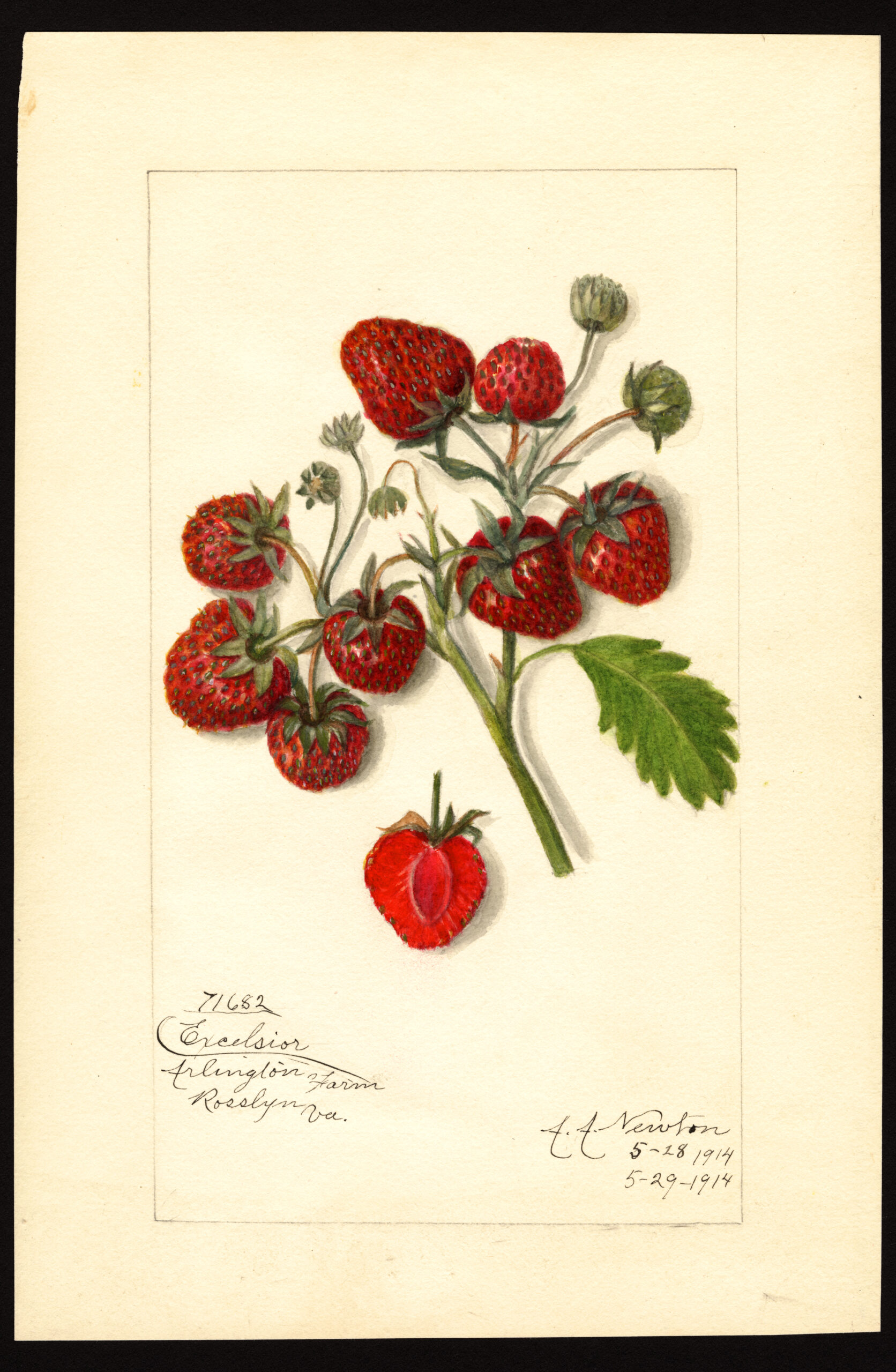

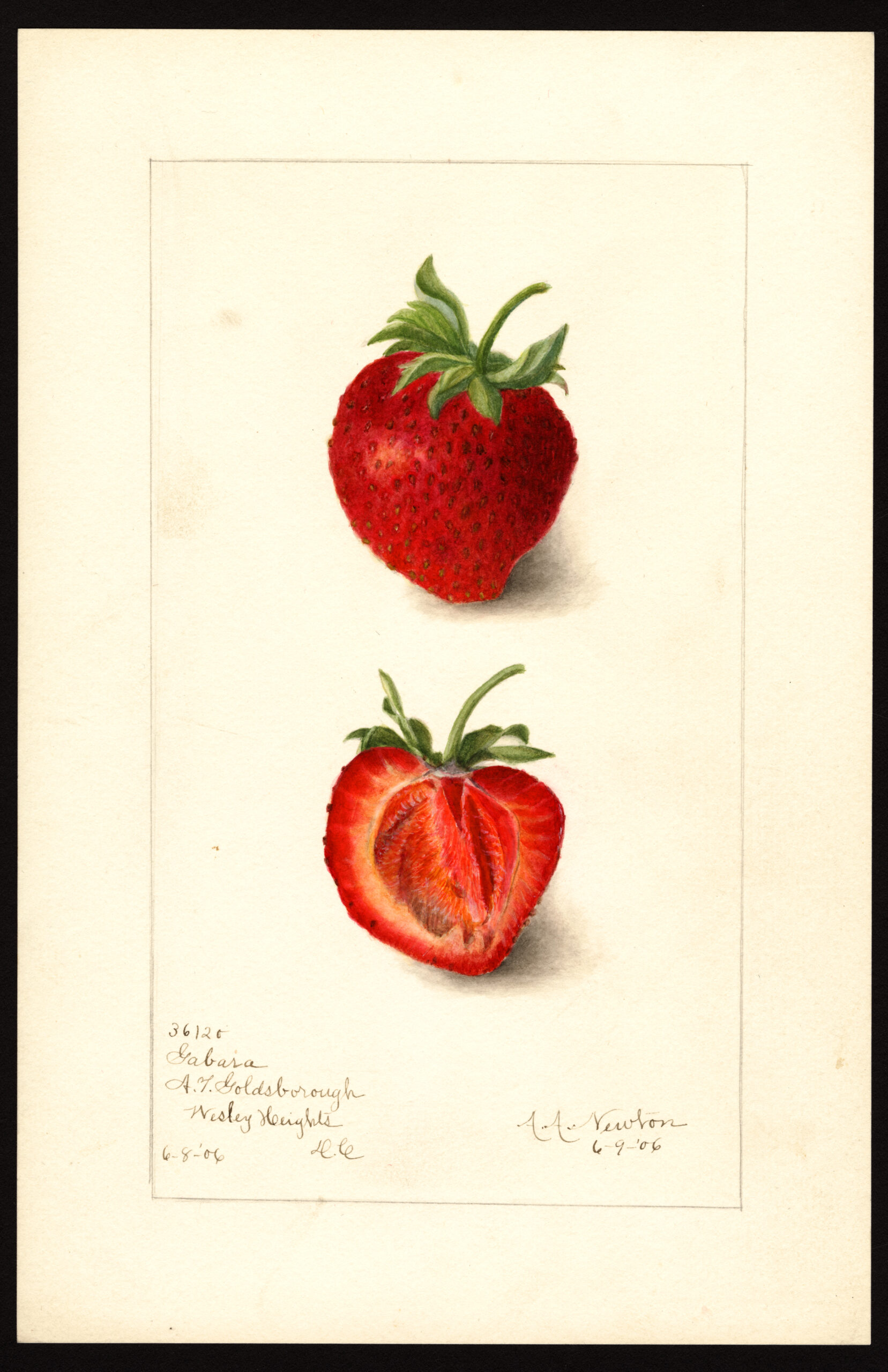
Both aesthetically and as a scientific database, the Pomological Watercolor Collection is the berries – specifically, Gandy, Chesapeake, Excelsior, Manhattan, and Gabara to namecheck but a few types of Fragaria, aka strawberries, preserved therein.
Other fruits remain lesser known on our shores. The USDA sponsored global expeditions specifically to gather specimens such as the ones below.
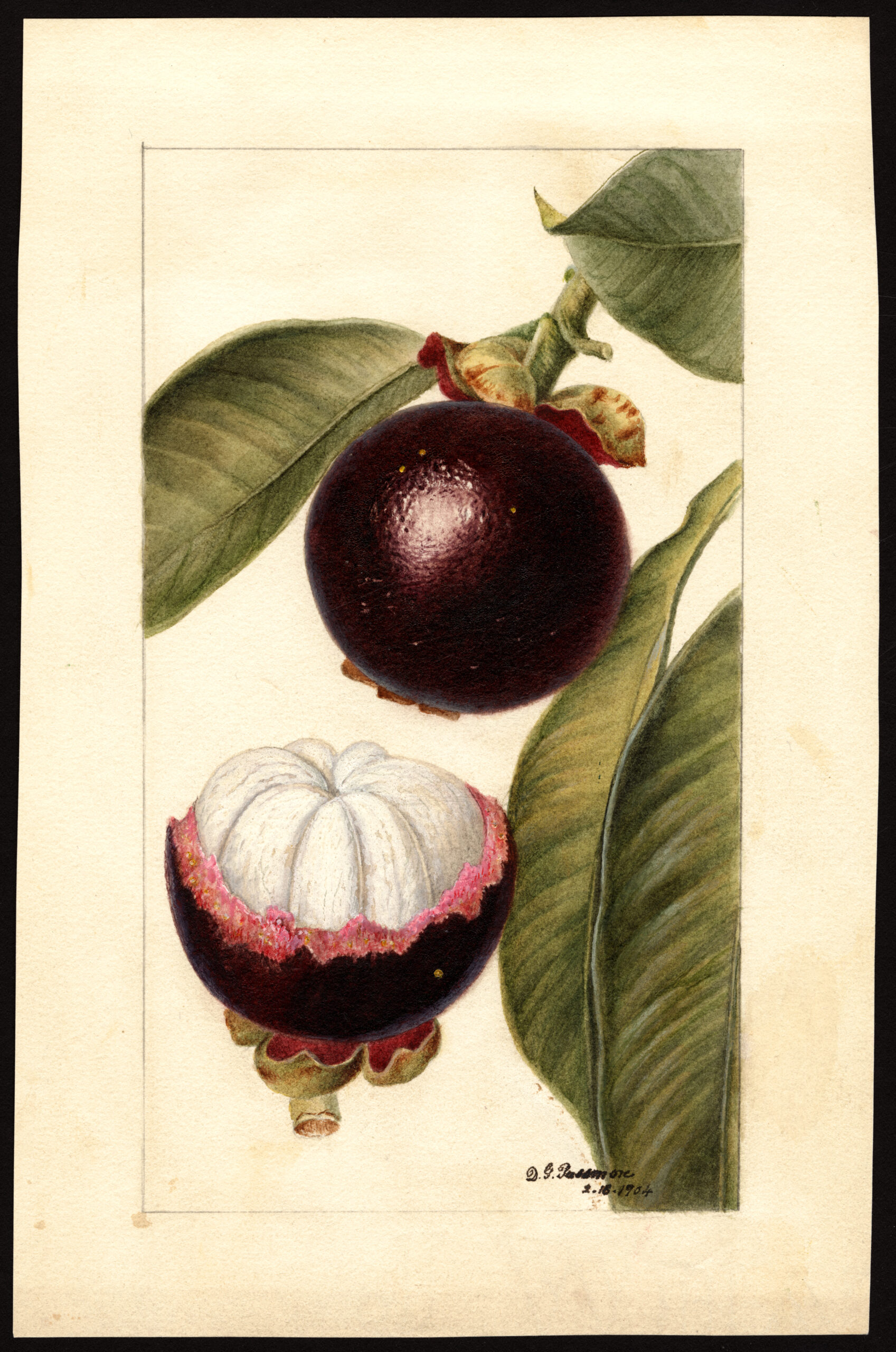
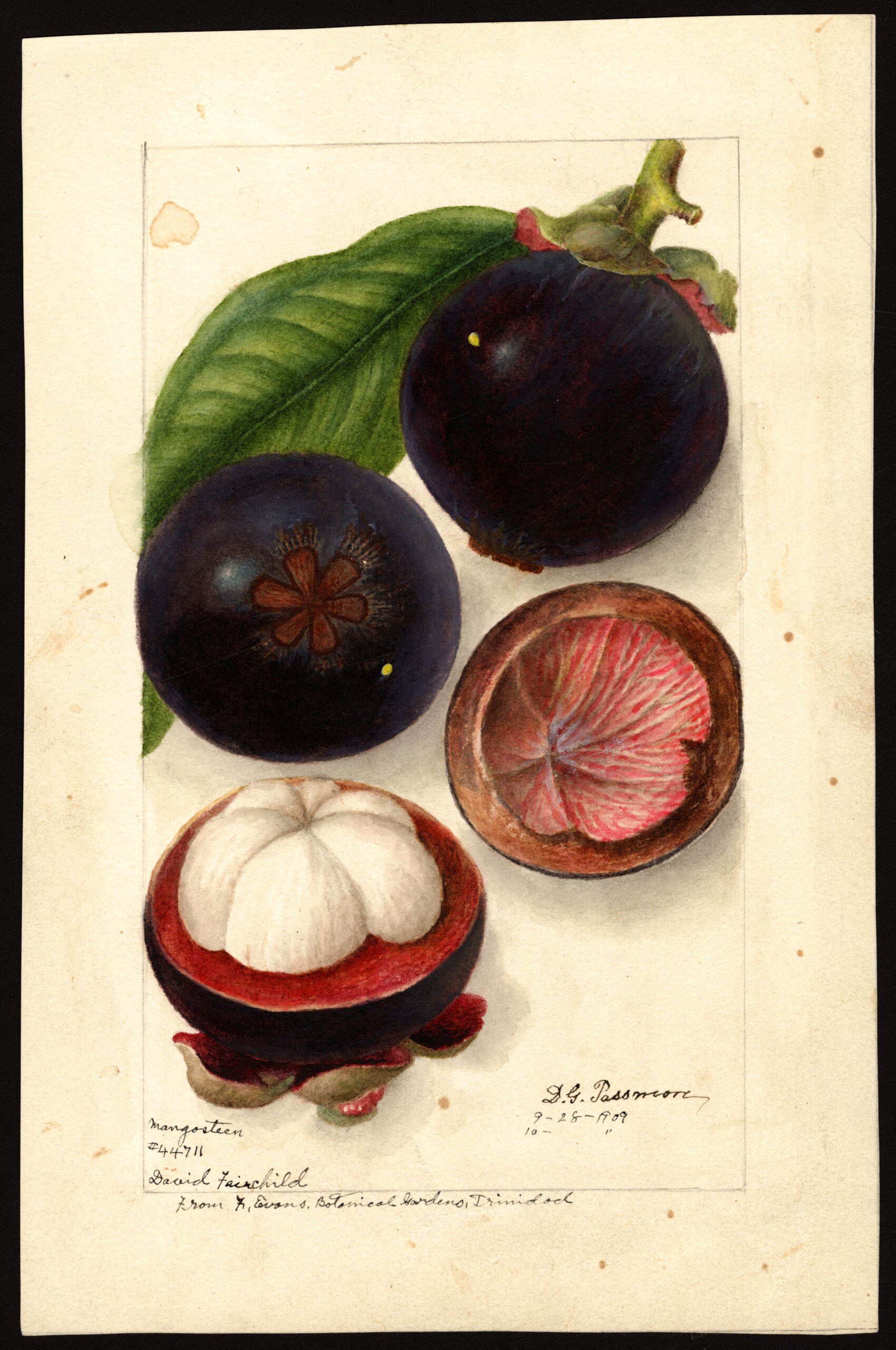
Queen Victoria reportedly offered knighthood to any traveler presenting her a mangosteen – still a rare treat in the west. They were banned in the U.S. until 2007 in the interest of protecting local agriculture from the threat of stowaway Asian fruit flies.

The thick, square-ended Popoulu banana would never be mistaken for a Chiquita from the outside. According to The World of Bananas in Hawai’i: Then and Now, its lineage dates back tens of thousands of years to the Vanuatu archipelago.
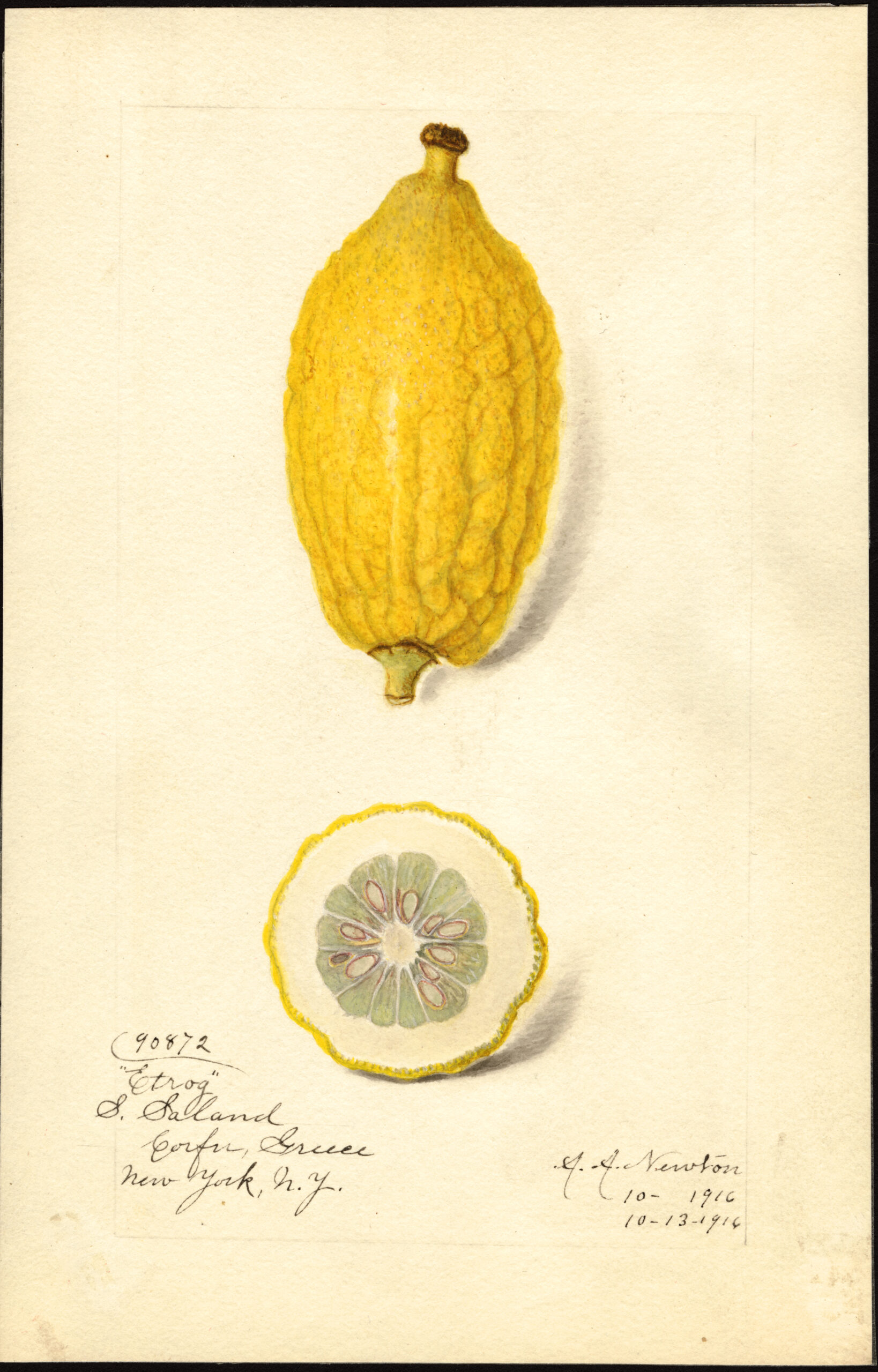
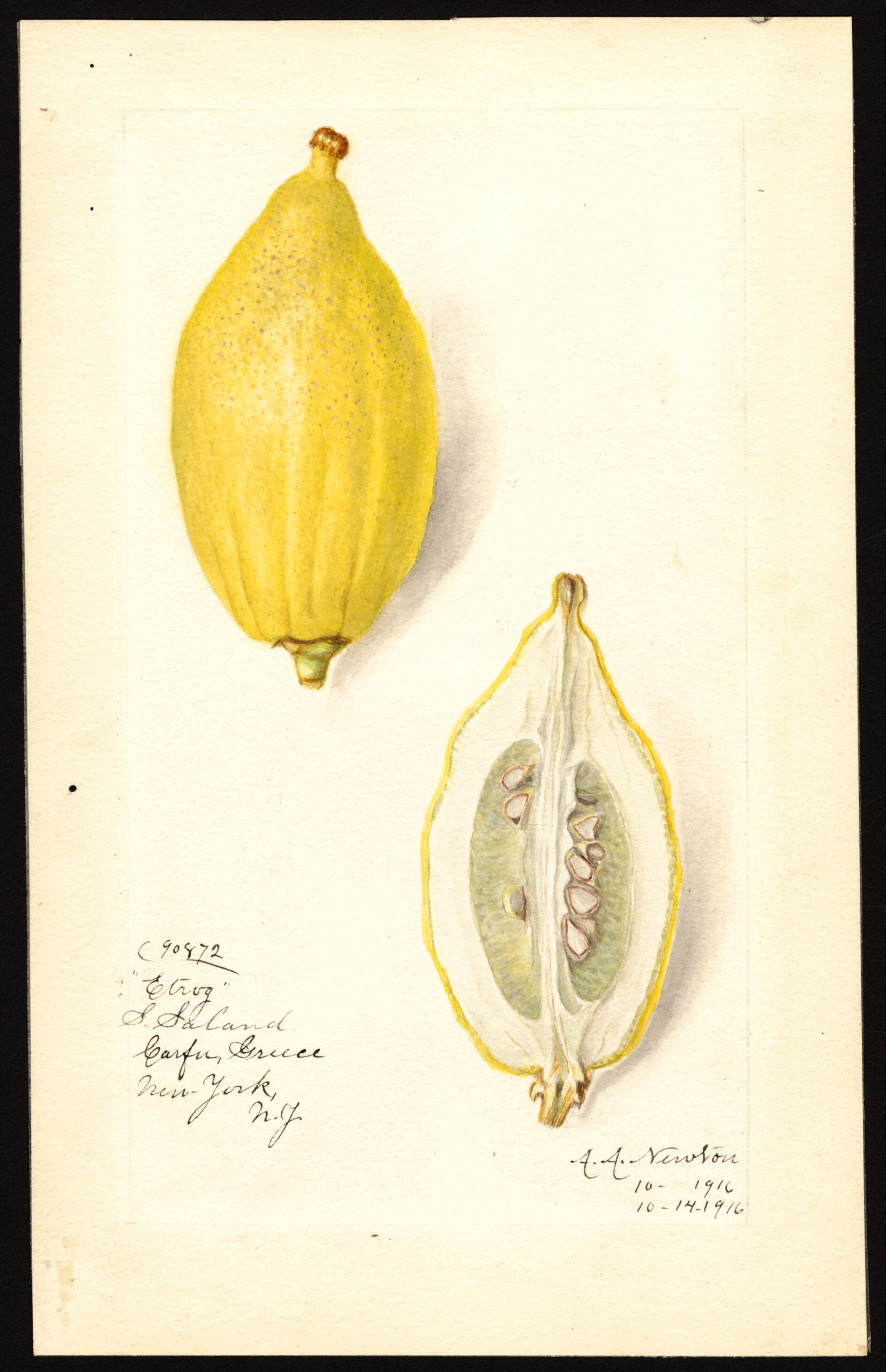
If you celebrate the harvest festival Sukkot, you likely encountered an etrog within the last month. The notoriously fiddly crop has been cultivated domestically since 1980, when a yeshiva student in Brooklyn, seeking to keep costs down and ensure that kosher protocols were maintained, convinced a third-generation California citrus grower by the name of Fitzgerald to give it a go.
Explore and download hi-res images from the Pomological Watercolor Collection here.
Related Content
A Collection of Vintage Fruit Crate Labels Offers a Voluptuous Vision of the Sunshine State
A Stunning, Hand-Illustrated Book of Mushrooms Drawn by an Overlooked 19th Century Female Scientist
Via Aeon
– Ayun Halliday is the Chief Primatologist of the East Village Inky zine and author, most recently, of Creative, Not Famous: The Small Potato Manifesto and Creative, Not Famous Activity Book. Follow her @AyunHalliday.
The Romans fashioned their buildings with concrete that has endured for 2,000 years. Their secret? Some researchers think it’s how the Romans heated lime. Others think it’s how they used pozzolanic material such as volcanic ash. Nowhere does coffee figure into the equation. Too bad.
Happily, researchers at the Royal Melbourne Institute of Technology (RMIT) University have discovered that “concrete can be made 30% stronger by replacing a percentage of sand with spent coffee grounds, an organic waste product produced in huge amounts that usually ends up in landfills,” writes New Atlas. Rajeev Roychand (above), the lead author of a study in the Journal of Cleaner Production, notes: “The disposal of organic waste poses an environmental challenge as it emits large amounts of greenhouse gasses including methane and carbon dioxide, which contribute to climate change. The inspiration for our work was to find an innovative way of using the large amounts of coffee waste in construction projects rather than going to landfills—to give coffee a ‘double shot’ at life.” If Roychand’s research findings endure, archaeologists and materials engineers might enjoy puzzling over the mysteries of coffee and concrete another two millennia from now.
You can read his study, “Transforming spent coffee grounds into a valuable resource for the enhancement of concrete strength” here.
If you would like to sign up for Open Culture’s free email newsletter, please find it here.
If you would like to support the mission of Open Culture, consider making a donation to our site. It’s hard to rely 100% on ads, and your contributions will help us continue providing the best free cultural and educational materials to learners everywhere. You can contribute through PayPal, Patreon, and Venmo (@openculture). Thanks!
Related Content
The Mystery Finally Solved: Why Has Roman Concrete Been So Durable?
How to Develop Photographs with Coffee
Is Coffee Good for You?: A Coffee Connoisseur Reviews the Scientific Research
Uma cliente das Filipinas teve uma experiência um tanto quanto desconfortável ao fazer um pedido de frango frito via delivery na popular rede de fast-food, Jollibee. Ao invés de encontrar a refeição esperada, Alique Perez e seu filho foram surpreendidos com uma toalha empanada.
Alique Perez relatou o incidente em sua página no Facebook: “Algo me frustrou hoje. Pedimos Jollibee via delivery e, quando estava tentando cortar o frango do meu filho, percebi que não conseguia tirar um pedaço de jeito nenhum. Foi quando coloquei minhas mãos para ver de perto e tive a surpresa: era uma toalha empanada e frita. Como alguém faz isso com uma toalha?”. O post rapidamente se tornou viral, recebendo mais de 100 mil curtidas e compartilhamentos.
Em resposta ao incidente, a rede Jollibee emitiu um comunicado oficial. A empresa anunciou o fechamento temporário da unidade onde o erro aconteceu, que durará três dias, com o objetivo de conduzir uma revisão completa de seus procedimentos de conformidade e treinamento da equipe. O comunicado da empresa enfatizou a gravidade do ocorrido: “Estamos muito preocupados com o caso e vamos conduzir uma investigação interna sobre o incidente. É lamentável que o procedimento padrão de preparação dos nossos alimentos tenha sido desviado por funcionários da loja. Também vamos enviar lembretes a todas as unidades a fim de garantir o cumprimento de todas as nossas exigências”.

Este incidente peculiar levanta questionamentos sobre a integridade dos processos de controle de qualidade e preparo de alimentos em redes de fast-food.
Enquanto a investigação interna da Jollibee prossegue, tanto os clientes quanto o público em geral aguardam a implementação de medidas rigorosas para evitar incidentes semelhantes no futuro, restaurando, assim, a confiança na marca.
Com informações de Revista Empresas e Negócios
The post Mulher pede delivery de frango frito e recebe toalha empanada appeared first on CONTI outra.
As a general rule, you can gain a decent understanding of any part of the world by eating its regional specialties. This holds especially true in a country like China, with its great size and deep history. Travel to the southeastern province of Fujian, for instance, and you’ve got to try guang bing or “shiny biscuit,” the Chinese equivalent of the bagel. “With flour, dietary alkali and salt, the cake, no bigger than a palm, can be simply cooked, and sells for about 1 yuan ($0.14) on the streets,” says China Daily. “Locals love it, not only because of the crispy and salty taste, but also because of a legendary story.”
The distinctive dishes of border or coastal areas always seem to have particularly intriguing histories, and so it is with the one behind Fujian’s guang bing. “During the Ming Dynasty (1368-1644), General Qi Jiguang brought an army to fight Japanese invaders in Fujian. Because of continuous rain, they could not cook for the soldiers, so Qi created a kind of cake with a small hole in the middle. Soldiers could string the cakes together and carry them while fighting the enemy.”
The result looks — and presumably tastes — like a necklace of bagels, the preparation of which could be accomplished in underground ovens that didn’t give away the soldiers’ position as clearly as open campfires would.
You can learn more about this bagel-powered victory of five centuries ago from the Great Big Story video at the top of the post, and more about the continued preparation and sale of guang bing by a few dedicated bakers in the Atlas Obscura video just above. Though plenty of Fujianese take them straight, “some like to add pork, or dried shrimp and Chinese chives in it; some fry it with chitterlings, duck’s gizzard or green been; and some break it into pieces and boil it with soup.” Written records of the bagel as Westerners know it date back to early seventeenth-century Poland, with apparent predecessors seen in that country as early as the late fourteenth century. It may naturally occur to an American traveler in China to unite these two long but distant culinary traditions, in which case he’d do well to pack his own with lox and cream cheese.
Related content:
A Brief History of Dumplings: An Animated Introduction
When Italian Futurists Declared War on Pasta (1930)
Bob Dylan Potato Chips, Anyone?: What They’re Snacking on in China
Philosophy Explained with Donuts
Based in Seoul, Colin Marshall writes and broadcasts on cities, language, and culture. His projects include the Substack newsletter Books on Cities, the book The Stateless City: a Walk through 21st-Century Los Angeles and the video series The City in Cinema. Follow him on Twitter at @colinmarshall or on Facebook.
It costs roughly $20,000, weighs nearly 100 pounds, and looks like a high-end microscope. Handmade in Switzerland, the MANUMENT Leva Machine makes espresso. How well does it make espresso? How do the shots taste?: According to coffee expert James Hoffmann–he’s the author of The World Atlas of Coffee—the shots have a texture that is “very enjoyable.” The texture is “silky, buttery and soft.” That verdict is sandwiched in the middle of a 20-minute review of the machine, which you can watch above.
If you would like to sign up for Open Culture’s free email newsletter, please find it here.
If you would like to support the mission of Open Culture, consider making a donation to our site. It’s hard to rely 100% on ads, and your contributions will help us continue providing the best free cultural and educational materials to learners everywhere. You can contribute through PayPal, Patreon, and Venmo (@openculture). Thanks!
Related Content
The Birth of Espresso: The Story Behind the Coffee Shots That Fuel Modern Life
Understanding Espresso: A Six-Part Series Explaining What It Takes to Pull the Ideal Shot
Coffee College: Everything You Wanted to Know about Coffee Making in One Lecture
How to Make Coffee in the Bialetti Moka Pot: The “Ultimate Techique”

Read a story set in the Middle Ages, Beowulf or anything more recently written, and you’re likely to run across a reference to mead, which seems often to have been imbibed heartily in halls dedicated to that very activity. The same goes for medieval-themed plays, movies, and even video games. Take Assassin’s Creed Valhalla, described by Max Miller, host of Youtube channel Tasting History, as “a history-based game of, like, my favorite time period — Saxons and Vikings, you know, fightin’ it out — so I’m assuming that there’s going to be mead in there somewhere.” He uploaded the video, below, in the fall of 2020, just before that game’s release, but according to the Assassin’s Creed Wiki, he was right: there is, indeed, mead in there.
Perhaps throwing back a digital horn of mead in a video game has its satisfactions, but surely it would only make us curious to taste the real thing. Hence Miller’s episode project of “making medieval mead like a viking,” which requires only three basic ingredients: water, honey, and ale dregs or dry ale yeast. (The set of required tools is a bit more complex, involving several different vessels and, ideally, a “bubbler” to let out the carbonation.)
In it he consults a thirteenth- or fourteenth-century manuscript (above) called the Tractatus de Magnetate et Operationibus eius, which includes not just a letter on the workings of magnets — and “a university handbook on the theory of numbers, proportions, and harmony” and “the seven signs of bad breeding; the seven signs of elegance” — but also “one of the oldest known surviving English mead recipes.”
“When you think of Saxons and Vikings, yes, you think of mead,” Miller says, “but mead actually got its start way before that,” evidenced in the alcohol-and-honey residue found on Chinese pottery dating to 7000 BC and a written mention in the Indian Rigveda. “I have tasted the sweet drink of life, knowing that it inspires good thoughts and joyous expansiveness to the extreme, that all the gods and all mortals seek it together,” says that sacred text. Even if Miller’s mead doesn’t make you feel like a god, it does have the virtue of requiring only a few days’ fermentation, as opposed to the traditional period of months. Toward the video’s end, he mentions having set one bottle aside to ripen further, and possibly to feature in a later episode. That was nearly three years ago; today, Tasting History fans can only speculate as to what alcoholic Valhalla that brew has so far ascended.
You can find the text of the medieval recipe below:
//ffor to make mede. Tak .i. galoun of fyne hony and to
þat .4. galouns of water and hete þat water til it be as
lengh þanne dissolue þe hony in þe water. thanne set hem
ouer þe fier & let hem boyle and ever scomme it as longe as
any filthe rysith þer on. and þanne tak it doun of þe fier
and let it kole in oþer vesselle til it be as kold as melk
whan it komith from þe koow. than tak drestis
of þe fynest ale or elles berme and kast in to þe water
& þe hony. and stere al wel to gedre but ferst loke er
þu put þy berme in. that þe water with þe hony be put
in a fayr stonde & þanne put in þy berme or elles þi
drestis for þat is best & stere wel to gedre/ and ley straw
or elles clothis a bowte þe vessel & a boue gif þe wedir
be kolde and so let it stande .3. dayes & .3. nygthis gif
þe wedir be kold And gif it be hoot wedir .i. day and
.1. nyght is a nogh at þe fulle But ever after .i. hour or
.2. at þe moste a say þer of and gif þu wilt have it swete
tak it þe sonere from þe drestis & gif þu wilt have it scharpe
let it stand þe lenger þer with. Thanne draw it from
þe drestis as cler as þu may in to an oþer vessel clene & let
it stonde .1. nyght or .2. & þanne draw it in to an
oþer clene vessel & serve it forth // And gif þu wilt
make mede eglyn. tak sauge .ysope. rosmaryne. Egre-
moyne./ saxefrage. betayne./ centorye. lunarie/ hert-
is tonge./ Tyme./ marubium album. herbe jon./ of eche of
an handful gif þu make .12. galouns and gif þu mak lesse
tak þe less of herbis. and to .4. galouns of þi mater .i. galoun of
drestis.
Related content:
How to Make Ancient Mesopotamian Beer: See the 4,000-Year-Old Brewing Method Put to the Test
5,000-Year-Old Chinese Beer Recipe Gets Recreated by Stanford Students
Bars, Beer & Wine in Ancient Rome: An Introduction to Roman Nightlife and Spirits
Discover the Oldest Beer Recipe in History From Ancient Sumeria, 1800 B.C.
Beer Archaeology: Yes, It’s a Thing
Based in Seoul, Colin Marshall writes and broadcasts on cities, language, and culture. His projects include the Substack newsletter Books on Cities, the book The Stateless City: a Walk through 21st-Century Los Angeles and the video series The City in Cinema. Follow him on Twitter at @colinmarshall or on Facebook.

In the neverending quest to elevate themselves above the fray, today’s mixologists – formerly known as bartenders – are putting a modern spin on obscure cocktail recipes, and resurrecting anachronistic spirits like mahia, Chartreuse, Usquebaugh, and absinthe.
Might we see a return of Vin Mariani, a Belle Époque ‘tonic wine’ that was hit with such august personages as Queen Victoria, Ulysses S. Grant, Alexander Dumas and Emile Zola?
Probably not.
It’s got coca in it, known for its psychoactive alkaloid, cocaine.
Corsican chemist Angelo Mariani came up with the restorative beverage, formally known as Vin Tonique Mariani à la Coca de Peroum, in 1863, inspired by physician and anthropologist Paolo Mantegazza who served as his own guinea pig after observing native use of coca leaves while on a trip to South America:
I sneered at the poor mortals condemned to live in this valley of tears while I, carried on the wings of two leaves of coca, went flying through the spaces of 77,438 words, each more splendid than the one before…An hour later, I was sufficiently calm to write these words in a steady hand: God is unjust because he made man incapable of sustaining the effect of coca all life long. I would rather have a life span of ten years with coca than one of 10,000,000,000,000,000,000 000 centuries without coca.
Mariani identified an untapped opportunity and added ground coca leaves to Bordeaux, at a ratio of 6 milligrams of coca to one ounce of wine.
Unsurprisingly, the resulting concoction not only took the edge off, it was accorded a number of healthful benefits in an age where general cure-alls were highly prized.
The recommended dosage for adults was two or three glasses a day, before or after meals. For kids, the amount could be divided in two.
Reigning masters of graphic design were enlisted to promote the miracle elixir.
Jules Chéret leaned into its energy boosting effects by depicting a comely young woman clad in skimpy, sheer yellow replenishing her glass mid-leap, while Alphonse Mucha went dark, claiming that “the mummies themselves stand up and walk after drinking Vin Mariani.”
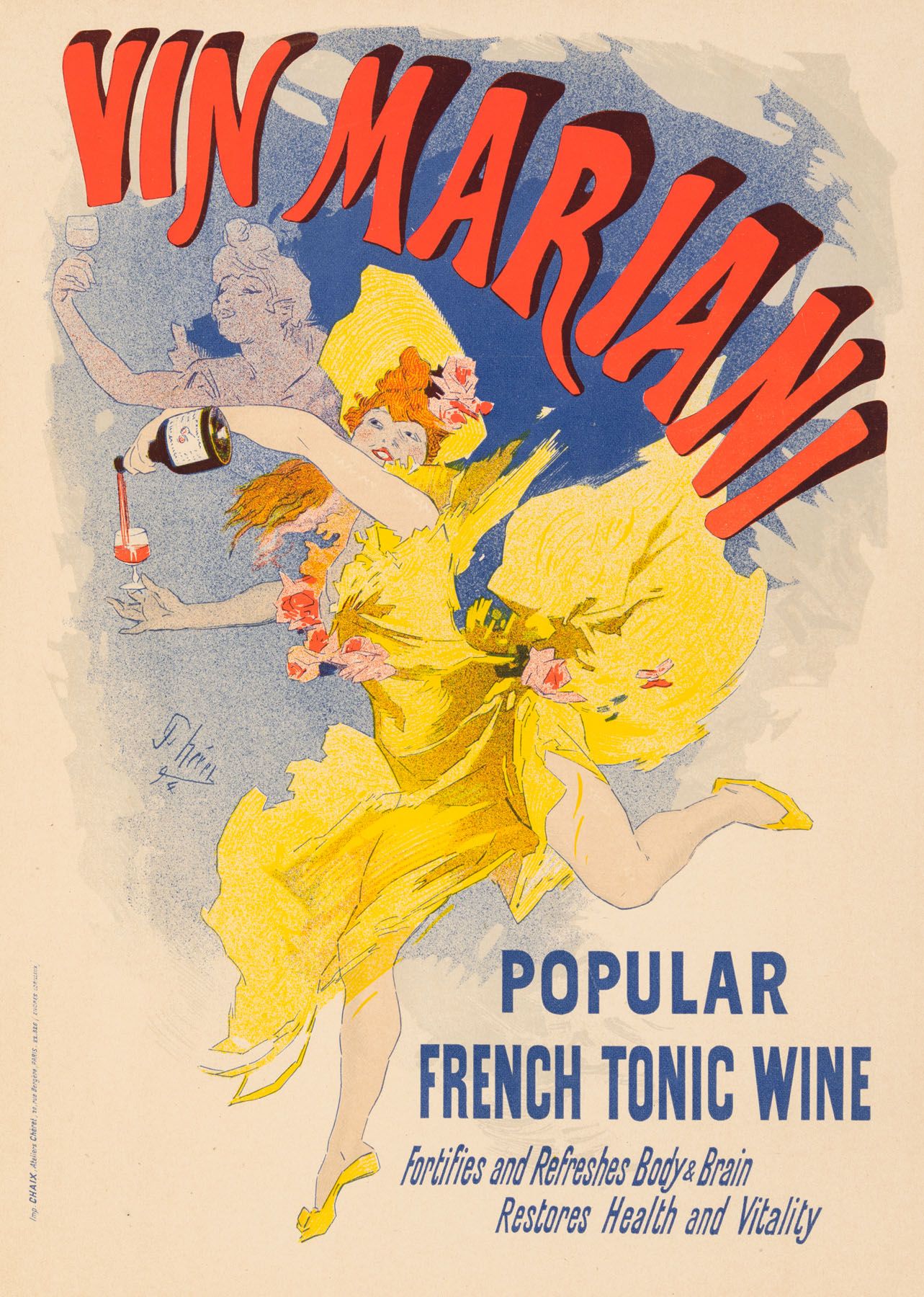
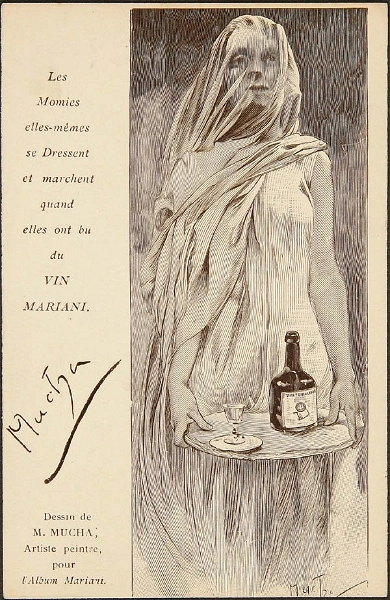
While we’re on the subject of corpse revivers, 21st-century mixologists will please note that a cocktail of Vin Mariani, vermouth and bitters, served with a twist, was a particularly popular preparation, especially across the Atlantic, where Vin Mariani was exported in a more potent version containing 7.2 milligrams of coca.
Angelo Mariani’s innovations were not limited to the chemistry of alcoholic compounds.
He was also a marketing genius, who curried celebrity favor by sending a complimentary case of Vin Mariani to dozens of famous names, along with a humble request for an endorsement and photo, should the contents prove pleasing.
These accolades were collected and repurposed as advertisements that assured adoring fans and followers of the product’s quality.

Sarah Bernhardt conferred superstar status on the drink, and not so subtly shored up her own, grandly pronouncing the blend the “King of Tonics, Tonic of Kings:”
I have been delighted to find Vin Mariani in all the large cities of the United States, and it has, as always, largely helped to give me that strength so necessary in the performance of the arduous duties which I have imposed upon myself. I never fail to praise its virtues to all my friends and I heartily congratulate upon the success which you so well deserve.
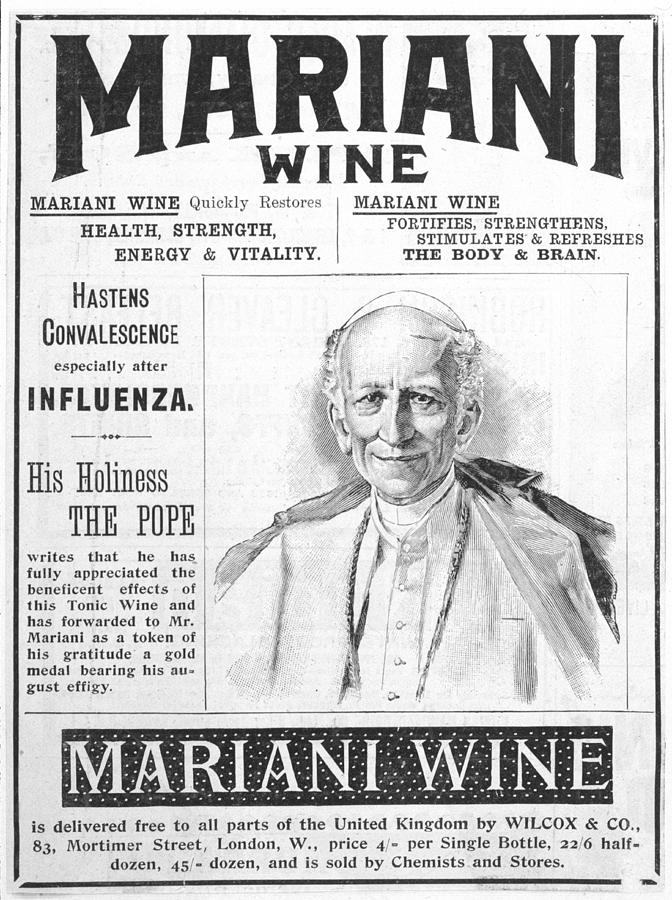
Pope Leo XIII not only carried “a personal hip flask” of the stuff to “fortify himself in those moments when prayer was insufficient,” he invented and awarded a Vatican gold medal to Vin Mariani “in recognition of benefits received.”
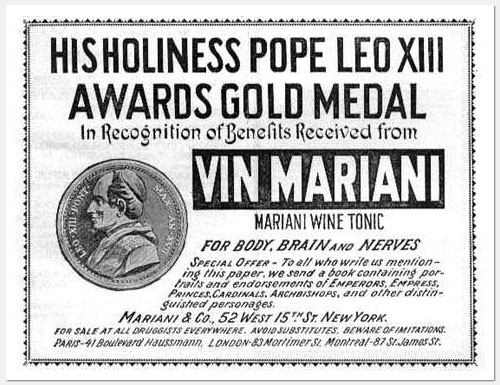
Mariani eventually packaged the glowing endorsements he’d been squirreling away as Portraits from Album Mariani. It’s a compendium of famous artists, writers, actors, and musicians of the day, some remembered, mostly not…
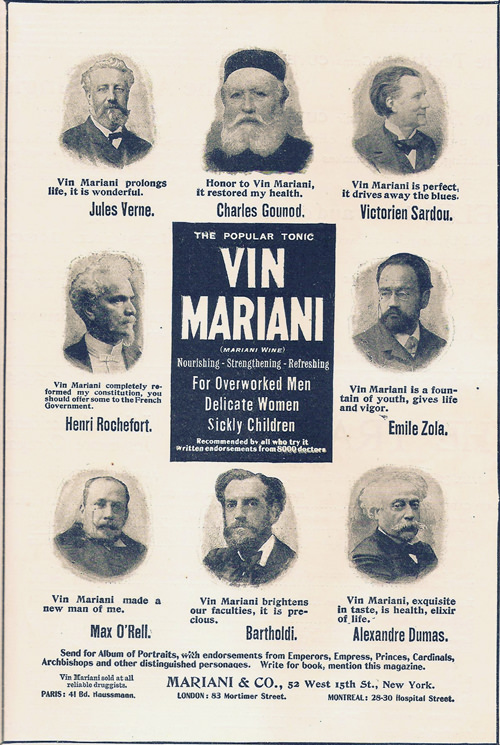
Composer John Philip Sousa:
When worn out after a long rehearsal or a performance, I find nothing so helpful as a glass of Vin Mariani. To brain workers and those who expend a great deal of nervous force, it is invaluable.
Opera singer Lillian Blauvelt:
Vin Mariani is the greatest of all tonic stimulants for the voice and system. During my professional career, I have never been without it.
Illustrator Albert Robida:
At last! At last! It has been discovered – they hold it, that celebrated microbe so long sought after – the microbe of microbes that kills all other microbes. It is the great, the wonderful, the incomparable microbe of health! It is, it is Vin Mariani!
(We suspect Robida penned his entry after swallowing more than a few glasses… or he was of a mischievous nature and would’ve fit right in with the Surrealists, the Futurists, Fluxus, or any other movement that jabbed at the bourgeoisie with hyperbole and humor.

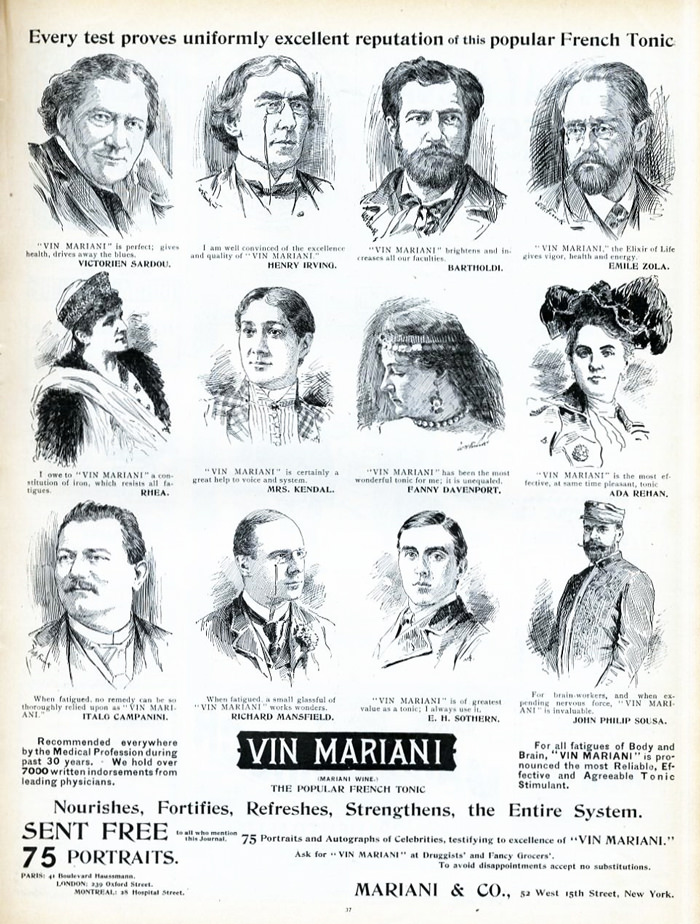

Mariani used the album to publish the Philadelphia Medical Times’ defense of celebrity endorsements:
The array of notable names is a strong one. Too strong in standing, as well as in numbers, to allow of the charge of interested motives.
Mariani also included an excerpt from the New York Medical Journal, denouncing the unscrupulous manufacturers of “rival preparations of coca” who pirated Vin Mariani’s glowing reviews, “craftily making those records appear to apply to their own preparations.”
Elsewhere in the album, medical authorities tout Vin Mariani’s success in combatting such maladies as headaches, heart strain, brain exhaustion, spasms, la grippe, laryngeal afflictions, influenza, inordinate irritability and worry.
They fail to mention that it could get you much higher than vins ordinaires, defined, for purposes of this post, as “wines lacking in coca.”
The psychoactive properties of coca definitely received a boost from the alcohol, a collision that gave rise to a third chemical compound, cocaethylene, a long-lasting intoxicant that produces intense euphoria, along with a heightened risk of cardiotoxicity and sudden death.
…some dead celebrities could likely tell us a thing or two about it.
Mariani’s fortunes began to turn early in the 20th century, owing to the Pure Food and Drug Act, the growing temperance movement, and increased public awareness of the dangers of cocaine.
We may never see a Vin Mariani cocktail on the menu at Death & Co, Licorería Limantour, or Paradiso, but the Drug Enforcement Administration’s Museum keeps a bottle on hand.
Related Content
How a Young Sigmund Freud Researched & Got Addicted to Cocaine, the New “Miracle Drug,” in 1894
The Coffee Pot That Fueled Honoré de Balzac’s Coffee Addiction
– Ayun Halliday is the Chief Primatologist of the East Village Inky zine and author, most recently, of Creative, Not Famous: The Small Potato Manifesto and Creative, Not Famous Activity Book. Follow her @AyunHalliday.
“We lunched up-stairs at Botin’s,” writes Ernest Hemingway near the end of The Sun Also Rises (1926). “It is one of the best restaurants in the world. We had roast suckling pig and drank rioja alta.” You can do the very same thing today, a century after the period of that novel — and indeed, you also could’ve done it two centuries before the period of that novel, for Botin’s was established in 1725, and now stands as the oldest restaurant in continuous operation. Founded as Casa Botín by a Frenchman named Jean Botin, it passed in 1753 into the hands of one of his nephews, who re-christened it Sobrino de Botín. Whatever the place has been called over this whole time, its oven has never once gone cold.
?si=-fSM9okYlxvKCpTd
“It is our jewel, our crown jewel,” Botín’s deputy manager Javier Sanchéz Álvarez says of that oven in the Great Big Story video above. “It needs to keep hot at night and be ready to roast in the morning.” What it has to roast is, of course, the restaurant’s signature cochinillo, or suckling pig, about which you can learn more from the Food Insider video just above.
“It’s exactly the same recipe and tradition,” says Sanchéz Álvarez. “Absolutely everything is done in the exact same way as in the old days,” down to the application of the spices, butter, wine, and salt to the raw pork before it enters the historic oven belly-up. “It’s very important that the skin of the cochinillo is very crunchy,” he adds. “If the skin isn’t crunchy, it’s not good.”
Needless to say, Botín is poorly placed to win the favor of the world’s vegetarians. But it does robust business nevertheless, having pulled through the COVID-19 pandemic (with, at the very least, its oven still lit), and more recently received a visit from superstar food vlogger Mark Wiens. Its enduring success surely owes to its more-than-proven ability to deliver on a simple promise: “We will serve you a hearty suckling pick with some good potatoes and a serving of good Spanish ham,” as Sanchéz Álvarez puts it. Working at the restaurant for more than 40 of its 298 years has made it “like home to me,” he says, employing the common Spanish expression of feeling como un pez en el agua — though, given the nature of Botín’s menu, a more terrestrial metaphor is surely in order.
via Mental Floss
Related content:
The Spanish Earth: Ernest Hemingway’s 1937 Film on The Spanish Civil War
Historic Spain in Time Lapse Film
A Visit to the World’s Oldest Hotel, Japan’s Nishiyama Onsen Keiunkan, Established in 705 AD
Based in Seoul, Colin Marshall writes and broadcasts on cities, language, and culture. His projects include the Substack newsletter Books on Cities, the book The Stateless City: a Walk through 21st-Century Los Angeles and the video series The City in Cinema. Follow him on Twitter at @colinmarshall or on Facebook.
O iFood foi condenado a pagar R$ 12 mil de indenização a uma cliente que foi vítima de um golpe praticado pelo entregador da plataforma. A decisão foi tomada pela justiça de São Paulo, que entendeu que “a prática do golpe somente foi possível por conta do acesso do fraudador aos dados pessoais da cliente presentes na plataforma digital”.
Leia mais
Segundo o juiz Alberto Villela, o Código do Consumidor estabelece que o fornecedor de um produto ou serviço é também responsável pelos atos dos seus prepostos ou representantes autônomos. Sendo assim, ele considerou que o iFood teve responsabilidades no caso, ocorrido em março.
Com informações de UOL.
Já assistiu aos novos vídeos no YouTube do Olhar Digital? Inscreva-se no canal!
O post Justiça condena iFood a pagar R$ 12 mil por golpe do entregador apareceu primeiro em Olhar Digital.